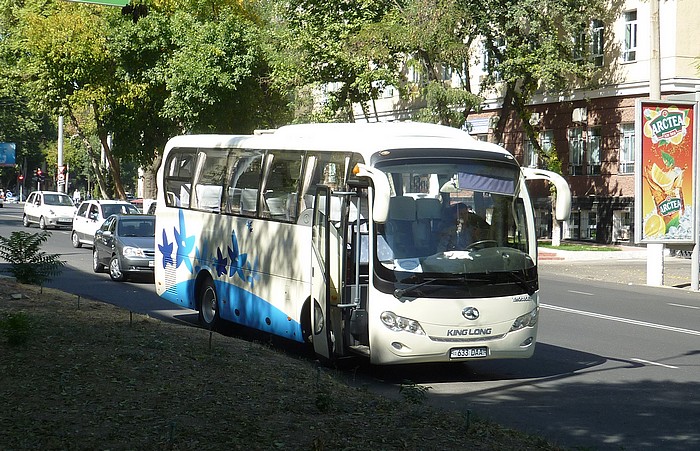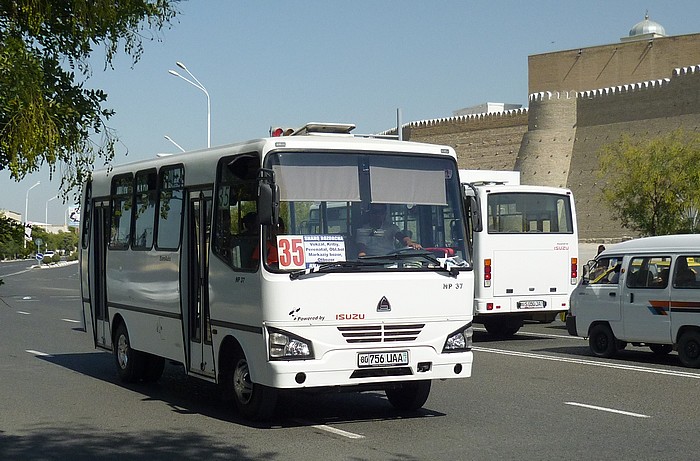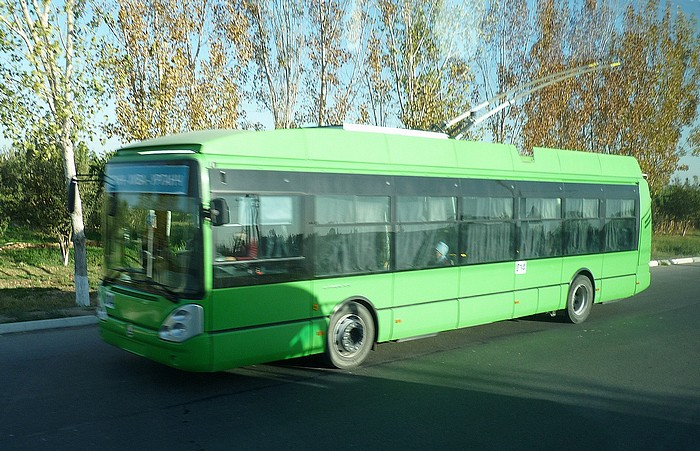

The Classic British Isles Buses Website
Transport in Uzbekistan - 2. Buses (by Dick Gilbert)
Last updated 29 August 2024
Email Events diary Past events list Classified adverts Classic U.K. Buses Classic Irish Buses Classic Manx Buses
| Aeroplanes in 2015 | Buses in 2015 | Cars in 2015 | Trucks in 2015 | Other transport in 2015 |
This addition to the Classic British Isles Buses Website International Section is the result of a visit to the Central Asian Republic of Uzbekistan in November 2015, and on this page we look at some of the buses in use there.
The visit to Uzbekistan included many of the historic cities along the ancient Silk Road that used to see camel caravans transporting exotic spices and textiles from China to Europe hundreds of years ago. Much of it survives to this day, but we travelled not by camel, but by Chinese-built tour coach, Spanish-built express train and European Airbus airliner.
Until 1991 Uzbekistan was a largely undeveloped region of the Soviet Union, so there are still quite a few signs of Russian transport influence there, and these were the bits that interested me most. We'll look at them later, but let's get the modern, boring stuff out of the way first - it get's more interesting as you work your way down the page! Many thanks to Dmitry Dedukh for helping me with Russian vehicle identities.

Quite typical of modern tourist transport is this trio of coaches at a lunch stop (in yurts!) in the desert between Urgench and Khiva in the far south west of the country. They are (left to right) a Chinese Yutong, a Chinese Zonda and a German Setra.

Here's a close-up of a Zonda (a different one) with the driver waving cheerily. This is a YCK6126HG1 working for a French tour company. The most numerous tourists in Uzbekistan are the French, followed by the Russians, and then the Chinese. The coach may be Chinese, but it has a Cummins engine.

This is a Higer, also Chinese, but I don't know what type. The location is in the middle of nowhere by a lake on the border with Turkmenistan. Vehicles stop here for a comfort break, but there are no facilities or food outlets. Just a few buildings and abandoned vehicles which you can hide behind! The ladies didn't enjoy this much.

This is a Zhongtong, also Chinese, and the first one I had ever seen. The driver is asleep, and it's in the same location as the Higer above. In the background is the highway from Khiva to Bukhara (the K is silent in both cases), about 300 miles long and gradually being rebuilt by teams of redneck Koreans. Our local guide was surprised to see the dog. He said it must be the last one left because the Koreans had eaten all the others.

Here's the King Long XMQ6858Y which drove us around the capital city Tashkent.

This is the inside of a Chinese Golden Dragon coach in Khiva. Never having travelled in one before I was quite pleasantly surprised by the trim, finish and comfort.

And this is the business end of another Golden Dragon coach in Tashkent.

Moving over to Korean products, this is a Ssangyong Istana Super Prime minibus seen out in the desert near Khiva.

Also Korean, and also out in the desert, is this very mauve Daewoo operated by Marco Polo Central Asia Travel of Tashkent. I think it's a BH115H which means it's not the newest coach in town, and could be as much as 20 years old.

When it comes to service buses, there are mainly three types. The smallest is a tiny Chevrolet microbus sort of thing, of which there are thousands running around like ants - that's one on the right. Next up is the SamAuto (Samarkand Automobile Factory) minibus with an Isuzu engine, which does most of the work in all towns and cities. They come in various sizes but this picture shows the largest one, the SAZ NP37 seating 37 passengers. In the background is the magnificent and ancient Bukhara city wall.

As you can see from this picture, where the fairing on the roof has fallen off, the SamAuto minibuses are not only powered by Isuzu, but also powered by gas.

The third type of service bus is the full sized version, which can only be found in the capital Tashkent, as far as I could tell. This is the livery for Tashkent municipal buses, but don't ask me what sort of Mercedes it is - they all look the same to me. It seems to have more doors than wheels. There are a couple of double deck Higer tour buses (with partly open tops) operating in Tashkent, but I think they are the only double deckers in the country.
My colleague Shane Conway says it looks like a Mercedes Citaro. Who am I to argue?
However in November 2016 I received the following from Marin Pazanin, who runs the excellent Autobusi.org website in Croatia. "The pictured bus is actually a Mercedes Conecto. It is very easy to be mistaken about this as for the second generation Conecto (the one in Uzbekistan), Mercedes basically used the first generation Citaro's bodywork, with some cosmetic changes. The Conecto is a cheap alternative to the Citaro and is usually found in Eastern Europe, especially in Turkey where it is built." Thanks Marin.

Now to more interesting matters. Since Tashkent abandoned its trolleybuses in 2010, the Urgench system (opened in 1997) is the only trolleybus network in Uzbekistan. Here I managed to catch a fleeting glimpse of Skoda no. 014 as it whizzed past on the long straight between Urgench and Khiva. There are fifteen in the fleet, six Skoda 14Tr13/6 acquired when the system was new, and nine Skoda 24Tr Iribus vehicles bought in 2013, of which this is one.

I only saw one of these classics. It is a LiAZ-677 bus picking up local traffic in a village near Bukhara. LiAZ (Likinskiy Avtobusnyi Zavod) built nearly 200,000 of this model at their bus plant in Likino near Moscow, from 1967 until the factory ceased production in 1996. This made the LiAZ-677 Russia's most common bus. The Likino plant has since reopened and is now a subsidiary of GAZ.

Like the LiAZ above, I only saw one of these classics. It is a KAvZ-685, a model that was manufactured in Kurgan in eastern Russia. It is essentially a GAZ-53 truck chassis (see my Uzbekistan trucks page) fitted with a passenger body. First produced in the early 1970s, the design was upgraded several times over the next twenty years or so. This particular example seems to be in use as a static catering van for the Korean road builders. KAvZ still put bus bodies on modern GAZ truck chassis.

Finally here are a couple of pictures of PAZ-672 buses. Pavlovsky Avtobusny Zavod built this model from 1968 until 1989 in their factory located in the city of Pavlovo, Nizhny Novgorod. This example (photo taken from our coach window as it sped past in the other direction - apologies for the quality) has been modified to run on gas and seems to be converted to a van.

Here is another PAZ-672 bus, this time in use as a mobile puppet show, parked alongside the glorious Bukhara city walls. I saw others converted to various configurations, such as mobile homes, vans and municipal service vehicles of unknown purpose.
Email Events diary Past events list Classified adverts Classic U.K. Buses Classic Irish Buses Classic Manx Buses